Fairey Gannet Video - Picture
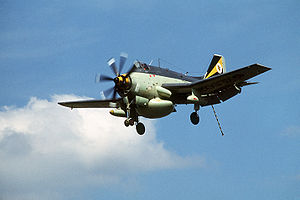
|
|
Fairey Gannet
Gannet

Picture - Fairey Gannet AEW.3 of the Royal Navy's Fleet Air Arm
Role: Anti-submarine warfare aircraft
National origin: United Kingdom
Manufacturer: Fairey Aviation Company
Designed by: H. E. Chaplin
First flight: 19 September 1949
Introduced: 1953
Retired: 15 December 1978
Primary users: Royal Navy
Royal Australian Navy
German Navy
Indonesian Navy
Produced: 1953-1959
Number built: 348
The Fairey Gannet was a British carrier-borne anti-submarine warfare and airborne early warning aircraft of the post-Second World War era developed for the Royal Navy's Fleet Air Arm by the Fairey Aviation Company. It is a mid-wing monoplane with a tricycle undercarriage and a crew of three, and double turboprop engine driving two contra-rotating propellers.
Design and development
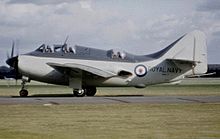
Picture - Gannet AS.4 newly assembled by Fairey Aviation at Manchester (Ringway) Airport in June 1956
The Gannet was built in response to the 1945 Admiralty requirement GR.17/45, for which prototypes by Fairey (Type Q or Fairey 17, after the requirement) and Blackburn Aircraft (the Blackburn B-54 / B-88) were built.
After considering and discounting the Rolls-Royce Tweed turboprop, Fairey selected an engine based on the Armstrong Siddeley Mamba: the Double Mamba (or "Twin Mamba"), basically two Mambas mounted side-by-side and coupled through a common gearbox to coaxial contra-rotating propellers. Power was transmitted from each engine by a torsion shaft which was engaged through a series of sun, planet, epicyclic and spur gears to give a suitable reduction ratio and correct propellershaft rotation. The ASMD 1 engine (2,950 hp/2,200 kW) was used in the Gannet AS 1; ASMD 3 (3,145 hp/2,345 kW) in the AS 4; and ASMD 4 (3,875 hp/2,889 kW) in the AEW 3 variant. The Double Mamba engine could be run with one Mamba stopped to conserve fuel and extend endurance for cruise flight. The contra-rotating propellers meant that when only half of the Double Mamba was running there were no thrust asymmetry problems. The Mamba exhausts were situated on each side of the fuselage, at the root of the wing trailing edge. The gas-turbine engine could run on kerosene, "wide-cut" turbine fuel or diesel fuel, allowing the Admiralty to eliminate the dangerous high-octane petroleum spirit required to operate piston-engined aircraft from carriers.
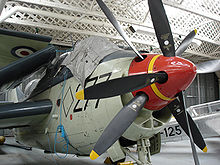
Picture - Fairey Gannet ECM.6 at the Imperial War Museum Duxford
The pilot is seated well forward, conferring a good view over the nose for carrier operations, and sits over the Double Mamba engine, directly behind the gearbox and propellers. The second crew member, an aerial observer, is seated under a separate canopy directly behind the pilot. After the prototype, a second observer was included, in his own cockpit over the wing trailing edge. This addition disturbed the airflow over the horizontal stabiliser, requiring small finlets on either side. The Gannet has a large internal weapons bay in the fuselage and a retractable radome under the rear fuselage.
The Gannet's wing folds in two places to form a distinctive Z-shape on each side. The first fold is at about a third of the wing length where the inboard anhedral (down-sweep) changes to the outboard dihedral (up-sweep) of the wing (described as a gull wing). The second wing fold is at about two-thirds of the wing length. The length of the nose wheel shock absorber causes the Gannet to have a distinctive nose-high attitude, a common characteristic of carrier aircraft.
Operational history
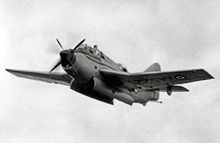
Picture - Gannet T.2 advanced trainer demonstrating with one-half of the Double Mamba shut down and weapons bay open
The prototype first flew on 19 September 1949 and made the first deck landing by a turboprop aircraft, on HMS Illustrious on 19 June 1950, by pilot Lieutenant Commander G. Callingham. After a further change in operational requirements, with the addition of a radar and extra crew member, the type entered production in 1953 and initial deliveries were made of the AS Mark 1 variant at RNAS Ford in April 1954. A trainer variant (T Mark 2) WN365 first flew in August 1954. The RN's first operational Gannet squadron (826 NAS) was embarked on HMS Eagle. The initial order was for 100 AS 1 aircraft. A total of 348 Gannets were built, of which 44 were the heavily modified AEW.3. Production was shared between Fairey's factories at Hayes, Middlesex and Stockport / Manchester (Ringway) Airport.
An Airborne Early Warning variant (AEW Mk 3) was developed to replace the American-supplied, piston-engined Douglas Skyraider aircraft. This aircraft carried the American AN/APS-20F radar in a large, bulbous radome suspended beneath the fuselage, under the wing leading edge, requiring a major structural redesign. The fin area was increased to counter increase in side area of the radome, and the undercarriage had to be extended to provide the necessary ground clearance, giving the AEW 3 a more-or-less level stance on the ground. The two radar operators were located in a cabin in the fuselage, accessed by small hatches over the wing trailing edge. This variant first flew in August 1958, with trials carried out with HMS Centaur in November. For stability, it required a redesigned fin and rudder together with the small vertical fins on the tailplane fitted to the other versions. When the AEW 3s were withdrawn and scrapped, their radar equipment was recycled into the Royal Air Force Avro Shackleton AEW 2.
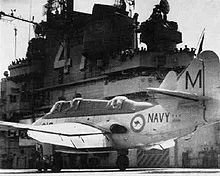
Picture - An Australian Gannet AS 1 on the USS Philippine Sea in 1958.
By the mid-1960s, the AS 1s and AS 4s had been replaced by the Westland Whirlwind HAS.7 helicopters. Gannets continued as Electronic countermeasures aircraft: the ECM.6. Some AS 4s were converted to COD 4s for Carrier onboard delivery-the aerial supply of mail and light cargo to the fleet.
The Royal Australian Navy purchased the Gannet (AS 1-36 aircraft). It operated from the aircraft carrier HMAS Melbourne and the shore base HMAS Albatross near Nowra, New South Wales. Indonesia bought a number of AS 4 and T 5s (re-modelled from RN AS 1s and T 2s) in 1959. Some Gannets were later acquired by various other countries.
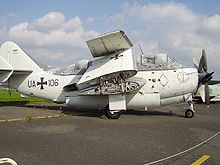
Picture - A preserved German AS.4
The Federal Republic of Germany bought 15 Gannet AS 4s and one T 5 in 1958. They operated as the anti-submarine squadron of Marinefliegergeschwader 2 (2nd Naval Fighter Wing) from Jagel and Sylt. In 1963 the squadron was re-assigned to MFG 3 at Nordholz until the Gannets were replaced by the Breguet Br.1150 Atlantique in 1966. During its operations the German Navy lost one AS 4, on 12 May 1966, when a Gannet crashed shortly after take-off from Kaufbeuren, killing all three crew members.
Accidents and Mishaps
21 November 1958 - Fairey Gannet AS.1, WN345, suffered belly landing during a test programme, caused by a partially retracted nosewheel. The pilot tried unsuccessfully to get the gear to deploy. He landed gear-up on a foam-covered runway at Bitteswell, suffering minimal damage. After repair, the Gannet was back in the air within weeks.
29 July 1959 - Royal Navy Fairey Gannet AS.4, XA465, could not lower the undercarriage, made a power-on deck belly landing into crash barrier on HMS Centaur. The crew was uninjured but the airframe was written off.
23 January 1964 - Royal Navy Fairey Gannet ECM.6 XG832 suffered double engine failure caused by a phosphor bronze bush on the idler gear of the port engine’s primary accessory drive failing. Fine metal particles from the gear were carried away by the shared oil system of the two engines, causing both to be destroyed. All three crew bailed out near St Austell and survived.
12 May 1966 - German Navy AS.4 UA-115 crashed shortly after take-off from Kaufbeuren, killing all three crew members. The crash was deemed the result of pilot error.
Harness restraint issues
Tests on the harness restraint system in the Gannet AEW3 were carried out in response to a mid-flight failure involving Royal Navy pilot Lieutenant K. P. Jones, and problems were found to stem from the housing through which the release cables were routed. The accident itself was the result of engine failure, most likely caused by a disconnection of the HP cock linkage on the starboard engine, but the more critical issue was the failure of the harness quick-release mechanism.
The following is Flag Officer Naval Air Command's citation for the Green Endorsement awarded to Lieutenant K. P. Jones:
"On May 19, 1973, Lieutenant K. P. Jones, Royal Navy was climbing away in a Gannet AEW after a night catapult launch from HMS Ark Royal sailing off the coast of Puerto Rico when the starboard engine RPM ran down to 60% and the propellor could neither be feathered and braked nor could the engine be relit. The aircraft had reached 4,000 feet but height could not be maintained in this configuration. Lieutenant Jones took control of the situation calmly, initiated a “Mayday” call and told his Observers to check their harnesses and run through emergency drills. He ordered them to bail out as the aircraft descended through 2,000 feet and then called each Observer by name to ensure that they had gone. Lieutenant Jones next attempted to bail out himself but the negative “G” harness strap would not release and he could not free himself from the cockpit. He was then committed to an unstrapped-in night ditching, as the remainder of the harness had fallen clear. He levelled off above the sea, judging his altitude by reference to the barometric altimeter and managed to slow the aircraft to about 70 knots before it stalled into the sea. Throughout, Lieutenant Jones displayed high professional ability, a strong sense of responsibility for the rest of his crew and excellent judgement in making a successful ditching under most demanding circumstances."
Lieutenant Jones next attempted to bail out himself but the negative “G” harness strap would not release and he could not free himself from the cockpit. He was then committed to an unstrapped-in night ditching, as the remainder of the harness had fallen clear. He levelled off above the sea, judging his altitude by reference to the barometric altimeter and managed to slow the aircraft to about 70 knots before it stalled into the sea.
Throughout, Lieutenant Jones displayed high professional ability, a strong sense of responsibility for the rest of his crew and excellent judgement in making a successful ditching under most demanding circumstances."
A brief report in Cockpit, Q4 1973, concerning the accident:
"A Gannet was launched at night from Ark Royal and climbed to 4,000 ft. Shortly afterwards the starboard engine ran down to 60%. Attempts to feather and brake the engine, and a subsequent re-light were unsuccessful and the aircraft was unable to maintain height. (It is considered that the most likely cause of the accident was disconnection of the HP cock linkage). Both observers bailed out at 1,800ft, but when the pilot tried to bail out he could not free himself from the negative 'G' strap. However, the rest of the harness had fallen clear and so the pilot was committed to a ditching without any restraint from shoulder or lap straps. This was successfully accomplished and the aircrew were all recovered safely and uninjured, the Observers by sea boats from HMS Ark Royal and HMS Devonshire and the pilot by Sea King. Although the ditching was successful, the most disturbing factor of the accident, was the inability of the pilot to release himself from the negative 'G' strap..."
Although the ditching was successful, the most disturbing factor of the accident, was the inability of the pilot to release himself from the negative 'G' strap..."
Markings
In FAA service, the Gannet generally wore the standard camouflage scheme of a Sky (duck-egg blue) underside and fuselage sides, with Extra Dark Sea Grey upper surfaces, the fuselage demarcation line running from the nose behind the propeller spinner in a straight line to then curve and join the line of the fin. Code numbers were typically painted on the side of the fuselage ahead of the wing; roundel and serial markings were behind the wing. The T.2 and T.5 trainers were finished in silver overall, with a yellow "Trainer band" on rear fuselage and wings.
Variants
Gannet AS.1 Three-seat anti-submarine version, 180 built. Gannet T.2
Training version of the Gannet AS.1. The Gannet T.2 trainer entering service in 1955, 35 built.
Gannet AEW.3
Airborne early warning aircraft for the Royal Navy. The Gannet AEW.3 entering service in 1958/1959, 44 built.
Gannet AS.4
Three-seat anti-submarine version, with improved performance from a more powerful engine, 82 built.
Gannet COD.4
AS.4 Gannets modified to operate as cargo/passenger transport aircraft.
Gannet T.5
Training version of the Gannet AS.4, eight built.
Gannet AS.6
Small number of Gannet AS.4s fitted with new radar and electronics.
Gannet ECM.6
Electronic countermeasures version, operating from shore bases.
Operators
Australia
Fleet Air Arm (Royal Australian Navy)
724 Squadron RAN
725 Squadron RAN
816 Squadron RAN
817 Squadron RAN
Germany
German Navy
Marinefliegergeschwader 2 (1958-63)
Marinefliegergeschwader 3 (1963-66)
Indonesia
Indonesian Navy (TNI-AL)
United Kingdom
Fleet Air Arm (Royal Navy)
700 Naval Air Squadron
703 Naval Air Squadron
703X Flight
719 Naval Air Squadron
724 Naval Air Squadron
725 Naval Air Squadron
737 Naval Air Squadron
744 Naval Air Squadron
796 Naval Air Squadron
810 Naval Air Squadron
812 Naval Air Squadron
814 Naval Air Squadron
815 Naval Air Squadron
816 Naval Air Squadron
817 Naval Air Squadron
820 Naval Air Squadron
824 Naval Air Squadron
825 Naval Air Squadron
826 Naval Air Squadron
831 Naval Air Squadron
847 Naval Air Squadron
849 Naval Air Squadron (AEW.3)
B Flight H.M.S.Ark Royal
D Flight H.M.S.Eagle
1840 Naval Air Squadron Royal Naval Volunteer Reserve
Survivors
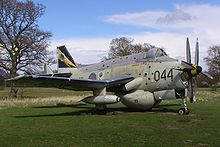
Picture - Gannet AEW3 XL472 at Gatwick Aviation Museum
Gannet T 2 XA508, Fleet Air Arm Museum
Gannet T 2 / T 5 Prototype WN365 now XT752 owned by Shannan Hendricks, New Richmond, Wisconsin, the world's last flying T5 under current refurbishment for return to flight status
Gannet T 5 XG883, Museum of Berkshire Aviation, Woodley, Berkshire, England
Gannet AEW 3 XL472, Gatwick Aviation Museum, Surrey, England
Gannet AEW.3 XL450, at the Flugausstellung Hermeskeil in Germany
Gannet ECM.6 XG831 at Davidstow Airfield and Cornwall at War Museum, Cornwall.
Gannet ECM.6 XA459 at White Waltham Airfield, England
Gannet ECM.6 XG797 at the Imperial War Museum at Duxford Airfield, Cambridgeshire
Gannet AS.1, Serial no. F9139 at Surabaya, Indonesia.
Gannet AS.1, Serial no. F9127 at Satria Mandala Armed Forces Museum Jakarta, Indonesia.
Gannet AEW3 XL502 at Yorkshire Air Museum, England
Gannet 841 at Moorabbin Air Museum, Victoria, Australia
Gannet AS.1 XA334, Camden Museum of Aviation, NSW, Australia
Gannet AS.1 XA331, Queensland Air Museum, Caloundra, QLD, Australia
Gannet AEW.3 G-KAEW (XL500) undergoing a full restoration to airworthiness
Gannet AEW MK.3 at Pima Air Museum, Arizona
Specifications (Gannet AEW.3)
Data from British Naval Aircraft since 1912
General characteristics
Crew: 3
Length: 44 ft (13.41 m)
Wingspan: 54 ft 4 in (16.57 m)
Height: 16 ft 10 in (5.13 m)
Wing area: 490 ft˛ (45.5 m˛)
Loaded weight: 25,000 lb (11,400 kg)
Powerplant: 1x— Armstrong Siddeley Double Mamba ASMD 4 turboprop, 3,875 hp (2,890 kW)
Propellers: 2 contra-rotating 4-bladed
Performance
Maximum speed: 250 mph (217 kn, 402 km/h)
Range: 700 mi (609 nmi, 1127 km)
Service ceiling: 25,000 ft (7,600 m)
Endurance: 5-6 hours
Armament
None
Comparable aircraft
Breguet Alizé
Grumman S-2 Tracker
Short Seamew
Tupolev Tu-91
Bibliography
Smith, Dave. "Hit The Deck." Flypast, No. 328, November 2008.
Sturtivant, Ray and Theo Ballance. The Squadrons of the Fleet Air Arm. London: Air-Britain, 1994. ISBN 0-85130-223-8.
Taylor, H.A. Fairey Aircraft Since 1915. London: Putnam, 1974. ISBN 0-370-00065-X.
Taylor, John W.R. "Fairey Gannet". Combat Aircraft of the World from 1909 to the Present. New York: G.P. Putnam's Sons, 1969 (reprinted 1977). ISBN 0-425-03633-2, ISBN 978-0425036334.
Thetford, Owen. British Naval Aircraft Since 1912. London: Putnam, 1978. ISBN 0-370-30021-1.
Velek, Martin, Michal OvÄŤxˇÄŤxk and Karel Susa. Fairey Gannet Anti-submarine and Strike Variants, AS Mk.1 & AS Mk.4 . Prague, Czech Republic: 4+ Publications, 2007. ISBN 80-86637-04-4.
Williams, Ray. Fly Navy: Aircraft of the Fleet Air Arm Since 1945. London: Airlife Publishing, 1989. ISBN 1-85310-057-9.
Willis, David. "Fairey's Versatile Gannet - Part Two", Air Enthusiast, Number 124, July-August 2006.
Fairey Gannet Pictures
More aircraft.
Source: WikiPedia